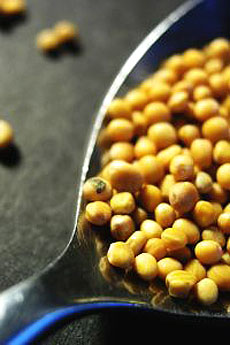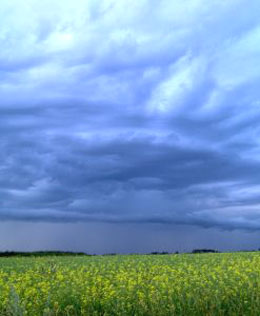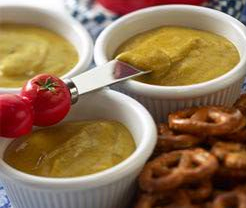

These mustard seeds aren’t spicy until they are cracked and mixed with a liquid—generally wine or vinegar. Photo of mustard seeds by Magda Skale | SXC.
|
VICTORIA MARSHMAN is an intern at THE NIBBLE.
|
|
August 2007
Updated July 2009
|
 |
The History Of Mustard
Page 3: How Mustard Is Made
This is Page 3 of a four-page article. Click on the black links below to visit other pages.
How Mustard Is Made

A field of mustard. Photo by Crystal Woroniuk | SXC.
|
 |
All mustard is made using the same basic procedure. The seed is crushed; depending on the type of mustard being made, the hull and bran are sifted out. Further grinding and crushing may be required, depending on the desired consistency of the finished mustard. A cold liquid such as beer, verjus, vinegar, water, wine—or a combination—is added, along with salt and spices (turmeric and cloves, e.g.) and other flavorings, if making a flavored mustard—blueberry mustard, honey mustard or tarragon mustard, for example (see our Mustard Glossary for many different types of mustard). In some cases the mustard is simmered to remove the bite, then cooled. Other mustards are aged in large containers.
|
Mustard Today
The countries that produce the most mustard are Canada, Hungary, India, the United Kingdom and the United States; a temperate climate is ideal to grow the mustard plant. Americans are a mustard-hungry nation, consuming more of the condiment than any other country.
Mustard is strangely omnipresent in popular culture, popping up in everything from The Beatles’ hit, “Mean Mr. Mustard,” to the blustery Colonel Mustard in the board game “Clue,” to the various mustard-colored clothes worn in the Harry Potter books. The condiment ranges widely from heavily processed ballpark mustard to elegant mustards that are the basis of sauces at the finest restaurants and is available in different textures, flavors and in pungency levels from acrid mustards to mustards so sweet you could eat them from the jar (thanks to sweeteners like honey and maple syrup).
How To Store Your Mustard
Mustard can be kept at room temperature; like any food product, it should be stored  away from heat and light. However, it is best refrigerated to preserve its flavor: The mustard oil that provides the spicy flavor, as well as the added spices and flavorings, will dissipate much more quickly if not refrigerated. The reason it can sit out on tables at diners is because it turns over quickly. away from heat and light. However, it is best refrigerated to preserve its flavor: The mustard oil that provides the spicy flavor, as well as the added spices and flavorings, will dissipate much more quickly if not refrigerated. The reason it can sit out on tables at diners is because it turns over quickly.
Photo of Delicae mustards.
Continue To Page 4: Mustard Trivia
Go To The Article Index Above

|




 away from heat and light. However, it is best refrigerated to preserve its flavor: The mustard oil that provides the spicy flavor, as well as the added spices and flavorings, will dissipate much more quickly if not refrigerated. The reason it can sit out on tables at diners is because it turns over quickly.
away from heat and light. However, it is best refrigerated to preserve its flavor: The mustard oil that provides the spicy flavor, as well as the added spices and flavorings, will dissipate much more quickly if not refrigerated. The reason it can sit out on tables at diners is because it turns over quickly.